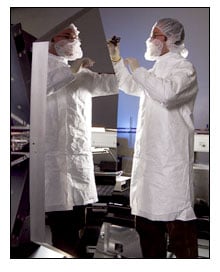ROCKY HILL, Conn., Sept. 23 -- Axsys Technologies Inc., a fabricator of large beryllium mirror substrates and structures used on space and defense applications, announced it is part of a team selected by Northrop Grumman Corp. to produce mirrors for NASA's James Webb Space Telescope, a next-generation successor to the Hubble Space Telescope.

LOW-WEIGHT MIRROR: Northrop Grumman has selected beryllium-based mirror technology as the primary mirror design for NASA's James Webb Space Telescope. At right, a technician mounts an alignment fiducial on a hexagonal beryllium mirror segment. The telescope's primary mirror will be made up of 18 segments approximately the size of this one. (Photo: Northrop Grumman)
The beryllium mirror team is lead by Ball Aerospace & Technologies Corp. and also includes Brush Wellman Inc. and Tinsley Laboratories. Brush Wellman will provide the beryllium material to Axsys. Axsys will produce beryllium mirror substrates and support structures for an engineering development unit, 18 optical mirror segments and two spare units and support structures that comprise the 6.5-meter primary mirror and the secondary mirror. The mirror substrates will then be polished and tested by Tinsley Laboratories, and Ball Aerospace will assemble the mirrors and support structures into the optical subsystem.
Axsys said it expects its selection to result in a multimillion dollar order with production delivery beginning in 2005 and continuing for three years.
Although the Webb will be 2.5 times the diameter of the Hubble Space Telescope, using beryllium for its mirror components -- as opposed to low-expansion glass optics -- will make it weigh a third as much. The size of the mirror will make the telescope "orders of magnitude more sensitive" than ground-based infrared telescopes, Axsys said.
The telescope is scheduled for launch in 2010 aboard an expendable launch vehicle. Unlike Hubble, space shuttle astronauts will not service the Webb, because it will be too far away. It will take about three months for the spacecraft to reach its destination, an orbit 940,000 miles or 1.5 million kilometers in space, called the second Lagrange Point, or L2, where the spacecraft will be balanced between the gravity of the Sun and the Earth.
To see into the depths of space, the telescope will also carry instruments that are sensitive to the infrared wavelengths of the electromagnetic spectrum, including a near-infrared camera, a multi-object spectrometer and a mid-infrared camera/spectrometer.
For more information, visit: www.axsys.com